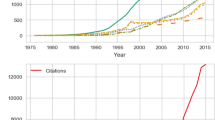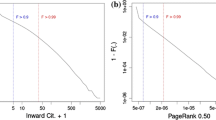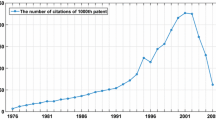Abstracts
By adopting a citation-based recursive ranking method for patents the evolution of new fields of technology can be traced. Specifically, it is demonstrated that the laser/inkjet printer technology emerged from the recombination of two existing technologies: sequential printing and static image production. The dynamics of the citations coming from the different “precursor” classes illuminates the mechanism of the emergence of new fields and give the possibility to make predictions about future technological development. For the patent network the optimal value of the PageRank damping factor is close to 0.5; the application of d = 0.85 leads to unacceptable ranking results.

Similar content being viewed by others
Notes
The source code is available under Supporting Information (Section 1).
All results of the top 100 ranked patents for each value of d are available under Supporting Information (Section 2 to Section 6).
References
Avrachenkov, K., Litvak, N., & Pham, K. S. (2008). A singular perturbation approach for choosing the PageRank damping factor. Internet Mathematics, 5(1–2), 47–70.
Boldi, P., Santini, M., & Vigna S. (2005). Pagerank as a function of the damping factor. In Proceedings of the 14th international conference on World Wide Web (pp. 557–566). Association for Computing Machinery, New York.
Brin, S., & Page, L. (1998). The anatomy of a large-scale hypertextual web search engine. Computer Networks and ISDN Systems, 30, 107–117.
Chen, P., Xie, H., Maslov, S., & Redner, S. (2007). Finding scientific gems with Google. Journal of Informetrics, 1, 8–15.
Csárdi, G., Strandburg, K. J., Tobochnik, J., & Érdi, P. (2009). The inverse problem of evolving networks—With application to social nets. In B. Bollobás, R. Kozma, & D. Miklós (Eds.), Handbook of large-scale random networks (pp. 409–443). New York: Springer.
Csárdi, G., Strandburg, K. J., Zalányi, L., Tobochnik, J., & Érdi, P. (2007). Modeling innovation by a kinetic description of the patent citation system. Physica A, 74(1–2), 783–793.
Ding, Y., Yan, E., Frazho, A., & Caverlee, J. (2009). Pagerank for ranking authors in co-citation networks. Journal of the American Society for Information Science and Technology, 60, 2229–2243.
Érdi, P. (2007). Complexity explained. Berlin: Springer.
Érdi, P., Makovi, K., Somogyvári, Z., Strandburg, K., Tobochnik, J., Volf, P., et al. (2013). Prediction of emerging technologies based on analysis of the U.S. patent citation network. Scientometrics, 95, 225–242.
Fleming, L. (2001). Recombinant uncertainty in technological search. Management Science, 47(1), 117–132.
Fleming, L., & Sorenson, O. (2001). Technology as a complex adaptive system: Evidence from patent data. Research Policy, 30, 1019–1039.
Fortunato, S., & Flammini, A. (2007). Random walks on directed networks: The case of PageRank. International Journal of Bifurcation and Chaos, 17, 2343–2353.
Hargadon, A., & Sutton, R. (1997). Technology brokering and innovation in a product development firm. Administrative Science Quarterly, 42, 716–749.
Henderson, R. M., & Clark, K. B. (1990). Architectural innovation: The reconfiguration of existing product technologies and the failure of established firms. Administrative Science Quarterly, 35(1), 9–30.
Langville, A., & Meyer, C. D. (2003). Survey: Deeper inside PageRank. Internet Mathematics, 1, 335–380.
Maslov, S. (2009). Promise and pitfalls of extending Google’s Pagerank algorithm to citation networks. The Journal of Neuroscience, 29, 1103–1105.
Mullis, K. B. (1993). http://www.nobelprize.org/nobel_prizes/chemistry/laureates/1993/mullis-lecture.html.
Perra, N., & Fortunato, S. (2008). Spectral centrality measures in complex networks. Physical Review E, 78, 036107.
Podolny, J. M., & Stuart, T. E. (1995). A role-based ecology of technological change. The American Journal of Sociology, 100(5), 1224–1260.
Podolny, J. M., Stuart, T. E., & Hannan, M. T. (1996). Networks, knowledge, and niches: Competition in the worldwide semiconductor industry, 1984–1991. The American Journal of Sociology, 102(3), 659–689.
Schumpeter, J. (1939). Business cycles. New York: McGraw-Hill.
Shaffer, M. (2011). Entrepreneurial innovation: Patent rank and marketing science. Ph.D. Dissertation, p. 213, Washington State University. https://research.wsulibs.wsu.edu/xmlui/bitstream/handle/2376/2902/Shaffer_wsu_0251E_10146.pdf?sequence=1.
Stonedahl, F., & Wilensky, U. (2009). Netlogo Pagerank model. http://ccl.northwestern.edu/netlogo/models/PageRank.
Strandburg, K., Csárdi, G., Tobochnik, J., Érdi, P., & Zalányi, L. (2007). Law and the science of networks: An overview and an application to the “patent explosion”. Berkeley Technology Law Journal, 21, 1293.
Strandburg, K., Csárdi, G., Tobochnik, J., Érdi, P., & Zalányi, L. (2009). Patent citation networks revisited: Signs of a twenty-first century change? North Carolina Law Review, 87, 1657–1698.
Tomlin, J. A. (2003). Paradigm for ranking pages on the world wide web. In Proceeding WWW’03 Proceedings of the 12th international conference on World Wide Web (pp. 350–355).
Valverde, S., Solé, R. V., Packard, N., & Bedau, M. (2007). Topology and evolution of technology innovation networks. Physical Review, 76, 056118.
Vigna, S. (2009). Spectral ranking. http://arxiv.org/pdf/0912.0238v13.pdf.
Walker, D., Xie, H., Yan, K. K., & Maslov, S. (2007). Ranking scientific publications using a model of network traffic. Journal of Statistical Mechanics: Theory and Experiment, 6, P06010.
Wasserman, S., & Faust, K. (1994). Social networks analysis. Cambridge, UK: Cambridge University Press.
Weitzman, M. L. (1996). Hybridizing growth theory. American Economic Review, 86(2), 207–212.
Acknowledgments
The authors benefited from discussions with colleagues and students both in Budapest and Kalamazoo. Special thanks to Gábor Csárdi, János Tóth and Péter Volf for commenting previous versions of the manuscript. PE thanks the Henry Luce Foundation for support of Complex Systems Studies as Henry R Luce Professor. JT thanks the Herbert H. and Grace A. Dow Foundation for support as the Dow Distinguished Professor of the Natural Sciences.
Author information
Authors and Affiliations
Corresponding author
Ethics declarations
Conflict of interest
The authors declare that they have no conflict of interest.
Electronic supplementary material
Below is the link to the electronic supplementary material.
Rights and permissions
About this article
Cite this article
Bruck, P., Réthy, I., Szente, J. et al. Recognition of emerging technology trends: class-selective study of citations in the U.S. Patent Citation Network. Scientometrics 107, 1465–1475 (2016). https://doi.org/10.1007/s11192-016-1899-0
Received:
Published:
Issue Date:
DOI: https://doi.org/10.1007/s11192-016-1899-0




